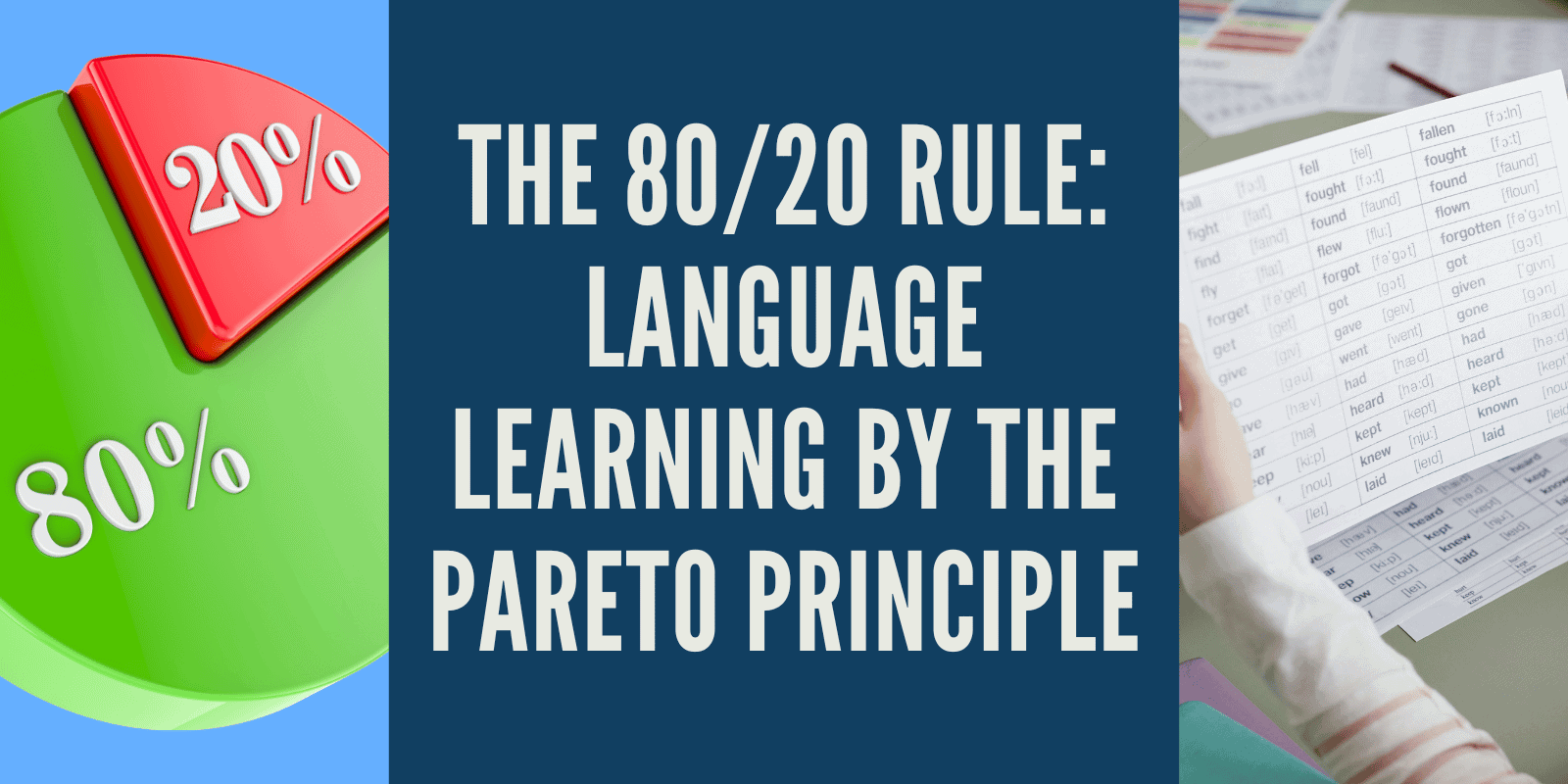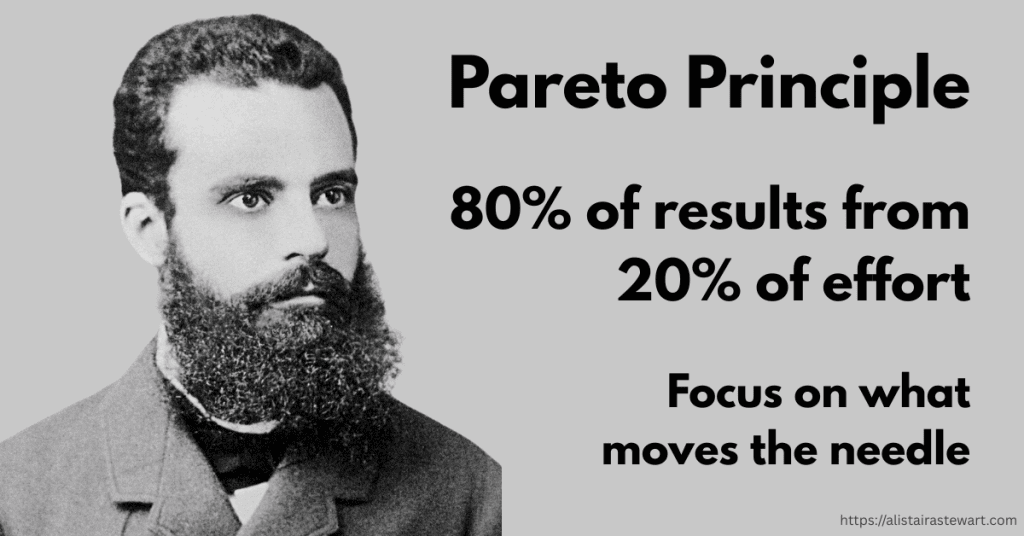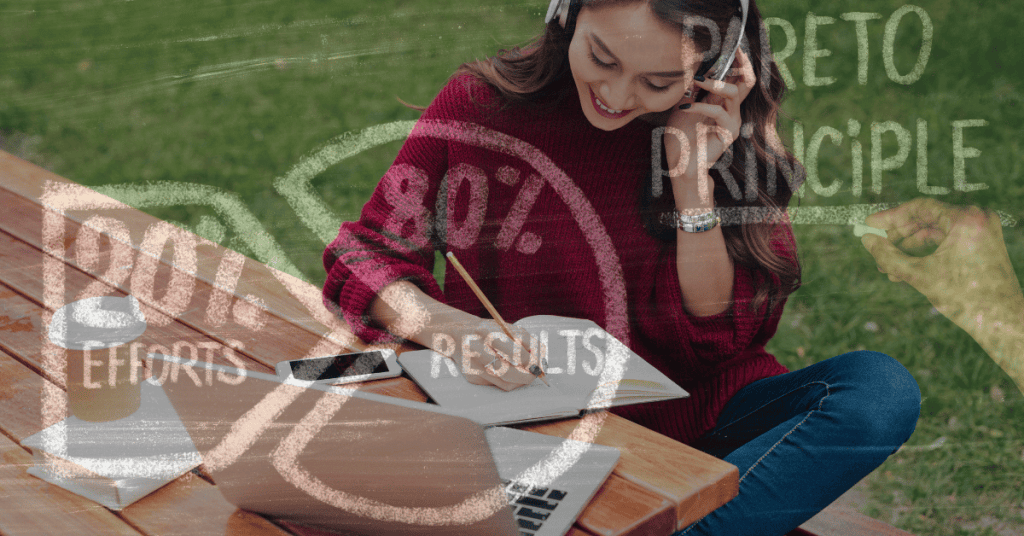The 80/20 Rule – Language Learning by the Pareto Principle

Applying the 80/20 Rule to language learning completely changed how I study. Like many language learners, I used to get stuck making slow progress, trying to memorise endless vocabulary lists. I’d spend hours studying, yet still couldn’t hold a basic conversation.
The Pareto principle explains why.
It says 80% of results usually come from just 20% of the effort. In language learning, that means focusing on common words, useful phrases, and core grammar rules instead of trying to learn everything at once.
In this post, I’ll share how I’ve applied this rule myself – what worked, what didn’t, and the specific tricks that helped me get to fluency faster. If you’ve ever felt stuck or overwhelmed when learning a language, this strategy might finally give you some relief.
The 80/20 Rule Language Learning Strategy
What Is the Pareto Principle?
The Pareto Principle is named after Italian economist Vilfredo Pareto, who noticed something strange back in the late 1800s. He saw that 80% of the wealth in his country was owned by just 20% of the people.
That pattern kept showing up everywhere – in business, in farming, even in his own garden.

Put simply, the Pareto principle states that 80% of results often come from just 20% of the effort. Most people waste time chasing the other 80%, not realising that the small slice they ignore is where the real progress comes from.
And once I got my head around that, it made me rethink the way I was studying.
In language learning, the connection is crystal clear. You don’t need to know every single rule to start speaking. Instead, you double down on the common words and phrases that you come across every day in real life.
That’s the 20% that gets you talking with native speakers instead of just flicking through textbooks.
Applying the 80/20 Rule in Practice
Examples of the 20% That Gives 80% of Results
When I finally sat down and asked myself, “What’s the stuff I actually use every day?” it was eye-opening. I realised most of my conversations – whether in English, Spanish, or French – were built on a surprisingly small group of common words and phrases.
Learning excess vocabulary at that point is only going to weigh you down. So identify what you actually need at that point and prioritise that.
Take English as an example. Research shows that knowing just 1,000 words gives you access to about 85% of everyday conversation.
Think about that: 1,000 out of over 170,000. That’s the kind of stat that makes you push the dictionary aside and focus on what really matters.
It’s the same with verbs in other languages. In Spanish, for example, if you get comfortable with just 10–15 of the most frequent verbs (like ser, estar, tener, hacer), you can already build hundreds of sentences.

French works the same way. Instead of getting bogged down with complex language constructions, you could be out there talking to people in your school, cafés, or markets.
And isn’t communicating the whole point of learning a new language anyway?
Vocabulary and Grammar with the Pareto Method
High-Frequency Words and Phrases
I often see people make significant gains in their communication when they stop trying to learn all the words at once and just go after the most common ones. These high-frequency words are the building blocks of real communication.
You’ll see them in every conversation, every book, and every TV show.
I have tested this myself with French. I focused only on the top 200 words, and suddenly I could follow the gist of YouTube videos and order food without freezing up. Was I fluent? No, but I could function with just these basics.
Even with just 100–300 words, you can handle a lot of everyday situations – asking for directions, buying a ticket, or introducing yourself.
Tools and Techniques for Faster Vocabulary Growth
Knowing what to learn is one thing. Actually remembering it is another.
I can’t recommend flashcards and spaced repetition systems (SRS) enough. They have forced me to practice active recall, so words stick with me instead of disappearing after a week.
I also make a habit of writing short sentences with new vocabulary so I can see it in context. Even silly examples help – like “The cat wants to buy coffee” – because they help me remember the vocabulary. You might have noticed these bizarre sentences in Duolingo.
And yes, I lean on apps and short courses too, especially when I need quick practice on the go, or just filling time on the train. It’s about creating simple habits that actually work.
Immersion Through the 80/20 Lens
Of course, learning vocabulary is only half the story. You also need to hear them in action.
When people hear the word “immersion,” they usually picture moving to a new country and watching TV all day in their new language.
Yes, you can binge – watch your favourite Netflix show in French, but it’s difficult to stay motivated if you keep getting lost.
Real immersion isn’t about drowning yourself; it’s about choosing focused input that actually gives you a return on your effort.
Something I recommend to students is to listen to native speakers in small, manageable ways. Things like short YouTube videos or podcasts about everyday topics that you enjoy. Or if you have a friend for some conversation practice, great!

Even if you don’t understand every word, you’ll get the idea, and you’ll start to recognise the most common phrases. And little by little, your fluency will improve.
Short stories or news articles are another great way to practice. These will give you confidence in the early stages, because you’re able to finish them and achieve something. And you’ll also start to notice patterns in the language.
Throw in a few language exchanges – where you speak half the time in your language and half in your partner’s – and you’ve got a simple but powerful immersion routine.
Active Recall and Spaced Repetition
Why Memory Techniques Work
I used to reread notes and feel “busy,” but nothing stuck when I had to speak.
Active recall fixed that – testing myself to answer without looking made the words stick. It’s harder, but that’s why it works.
Spaced repetition is the other side of the coin. Reviewing words and phrases right before forgetting them keeps them fresh, and you spend way less total study time.
Both methods fit neatly with the 20 rule. Instead of drilling everything, I only review the high-frequency words, core phrases, and grammar rules I actually need in conversations.
Ten minutes a day with a small deck beats hours of cramming random and pointless vocabulary.
The 80/20 Rule for Beginners and Intermediate Learners
For beginners, the trick is to grab the quick wins. I’m sure in my first week of studying Spanish, I only learned greetings, numbers, and how to order food.
But that tiny set of survival phrases was enough to handle shops, cafés, and small talk. And it gave me the confidence to keep going.
At the intermediate level, things change. You already know the basics, but progress slows, and it feels like a plateau.
That’s when I shifted my focus to weak spots: linking words like however or although, polishing my pronunciation, and practising verbs in more complex tenses.
Targeting those gaps will make you sound much more fluent in real conversations.
Common Mistakes to Avoid
One of the biggest traps here is thinking the 80/20 rule means you can completely ignore everything else. But it’s not about skipping the rest forever. It’s about starting with the pieces that give you momentum.
The other 80% comes later, once you’ve built a strong foundation.
Another mistake people make is memorising vocabulary in isolation, without real sentences or context. They can parrot the words back, but when a native speaker asks them something, they freeze.
And then there’s the “app overload” or “shiny object syndrome”. Apps are great and can teach you a lot, but choose one and stick with it. Mondly, for example, incorporates active recall and spaced repetition into its course and prioritises vocabulary based on the 80/20 rule.
A simple, focused curriculum beats a dozen scattered resources every time.
Practical Tips to Maximise Progress
What’s worked best for me is keeping study blocks short and focused.
Even just two hours a week with the right lessons beats ten hours of unfocused cramming. Small chunks are easier to stick with, and you don’t burn out.
I also like to translate little bits of my own life into my target language. Shopping lists, to-do lists, or even conversations in my own head. It feels silly at first, but it sneaks practice into my day without needing extra time.
Another habit that helped was writing short sentences and asking instructors or exchange partners to check them. These kinds of things can be quick wins.
The other thing is not to skip these wins. Celebrate hitting milestones and reward yourself – it will keep you motivated and help build confidence.

Work Smarter, Not Harder in Language Learning
So your main takeaway from this should be that fluency isn’t about knowing everything. It’s about prioritising and using the essentials frequently until they become second nature.
Figure out the pieces of your target language that really matter. The high-frequency words, key phrases, and simple grammar constructions – and make them your 20%.
The rest will come naturally once you’re already communicating.
So if you want to stop spinning your wheels, apply the 80/20 rule language learning strategy. It’ll get you speaking sooner, feeling more confident, and moving toward fluency faster than you think.






